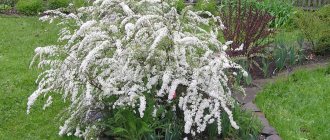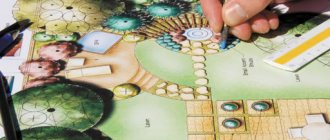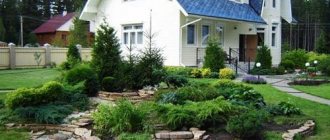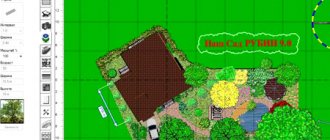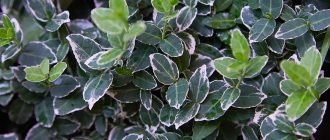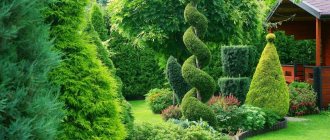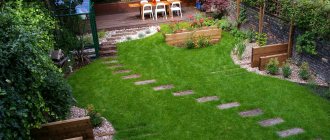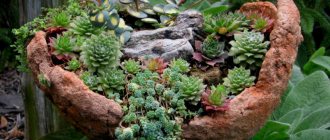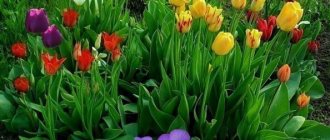When choosing plants for the garden, an important criterion is the ability to grow in natural conditions. To ensure a beautiful garden with little waste, the botanical set of crops includes perennial crops that do not need to be replanted annually. Flowers only complement the overall ambience. The basis of the composition is made up of trees and large shrubs.
Each plant has its own charm.
Features of using plants in garden landscape design
Green spaces perform several functions at once:
- decorative, create a certain mood, atmosphere;
- practical - trees provide beneficial shade on a hot day, fruit crops are grown for harvest;
- corrective - plants visually level out the unevenness of the natural relief;
- camouflage - a hedge protects from prying eyes and pets; vines mask imperfections in walls and fences.
Beautifully flowering perennials impress with their color during the flowering period.
The main purpose of plants is to produce oxygen and process carbon dioxide through photosynthesis.
Video about ornamental trees for your garden
To arrange a garden, everyone chooses their own path: some gardeners plant only fruit crops, others only coniferous trees and shrubs, and still others develop a garden design so that different plants are planted.
In any case, let each plant planted grow and begin to delight the eyes of the owner of the site and delight friends who come to visit.
Write in the comments what other beautiful plants for the garden can be added to this list.
Please rate our material:
Main types of trees and shrubs
It is impossible to list all the names of plants used in landscape design. Among the large species there are:
- columnar - an even cylindrical crown is formed;
- weeping species look unusual;
- standard - with the lower part of the trunk exposed, a round crown is formed at a certain height from the ground;
- dwarf ones are characterized by short stature and form curved intertwining shoots.
Decorative foliage plants are valued for their unusual shape or color of foliage.
Important! When choosing crops for garden decoration, preference is given to zoned species that are resistant to frost and fungal infections.
Beautiful flowering shrubs
In the list of popular types you can find:
- mock orange, because of its pleasant aroma the plant has a second name - jasmine;
- barberry, decorative species with red or burgundy oval leaves are especially valued, the bush lends itself well to shaping;
- Japanese quince or chaenomeles is valued for the decorative shape of its flowers and bright fruits that decorate the autumn garden (grown in flower beds and as a hedge);
- lilac, choose varieties with heart-shaped or lanceolate leaves, different flowering periods, and bud sizes;
- buddleya - reminiscent of lilac, only double;
- spirea is characterized by abundant flowering, the bush is completely covered with inflorescences;
- All kinds of hydrangeas are usually grown in groups, choosing varieties with round, conical or paniculate lush flower caps.
Note! Hydrangeas love slightly acidic soil and change color when the acidity level changes.
Evergreen shrubs and trees
Among other tall plants for the garden, conifers should be noted. Such trees and bushes remain attractive all year round. You only need to care for them during the growth phase. Spruce trees prefer flooded areas where melt water persists for a long time. Pines tolerate drought well. Thuja looks impressive; the crown of thuja can be round, conical, pyramidal, or oval (some species grow faster in width).
Almost all coniferous plants are suitable for creating artificial landscapes.
Weeping larch was bred for decoration; it is the only representative of conifers that sheds its needles for the winter. Junipers are shade-loving and do not like bright sun.
Juniper is a coniferous plant widely in demand in landscape design.
Decorative foliage plants
Maples are chosen with green or reddish foliage. Weeping rowan is a cultivated variety of ordinary rowan. A special place is occupied by variegated shrubs: derain, holly, euonymus, weigela. Bladderwort is distinguished by large berries. Zoned rhododendrons overwinter well under shelters.
During the flowering of rhododendron, any garden acquires a unique atmosphere; harmony and exquisite style are felt in it.
Other possible types
In garden design you can find fruiting dwarf pears and apple trees. Berry crops look decorative: honeysuckle, viburnum. Elderberry and hazel are valued for their decorative leaves.
Well-drained soil of any type is suitable for growing elderberries.
Landing rules
The rules for planting plants are not complicated. The planning stage requires serious preparation, since the flower garden will be perennial. It is necessary to clearly consider the planting scheme, using a ready-made one or your own, and determine the location on the site. Depending on whether it will be sunny or shaded, select varieties, purchase seedlings, stones, bedding.
In order to correctly place each of the species, you need to read about them in advance, find out the metric characteristics (height, width) of an adult plant, requirements for environmental conditions and agricultural technology.
If the final width of the thuja is 1 m, then when planting the distance to neighboring plants should be at least 0.5 m on each side
Before starting to dig holes, designers advise placing the purchased seedlings on the ground in accordance with the chosen pattern and assessing the location from different sides.
Many gardeners, believing that conifers grow slowly, plant everything very densely. As they grow, such plantings become denser, lose their decorative properties, and are more likely to suffer from diseases. Don't be afraid of empty spaces in the flowerbed. They can be decorated with large stones, hummocks of sedge, bright clumps of profusely and long-flowering annuals: alyssum, lobelia, thin-leaved marigolds, ever-flowering begonia.
Almost all conifers are undemanding in terms of soil type, fertility, and composition, but it is still better to add peat, sand, and compost when digging. At the bottom of the planting holes (for trees their depth is at least 50 cm) a drainage layer is poured - sand, pebbles, expanded clay. The seedling is carefully transferred from the container and lowered into the hole. Cover with earth, carefully compacting it with your hand so that there are no voids.
Experts recommend buying coniferous seedlings only from ZKS. When transshipping them, it is important to prevent damage to the earthen clod.
The plantings are watered abundantly, the ground is immediately mulched with bark, pebbles, and small cones collected from the pine forest.
Main types of flowers and grass
For lawns, ready-made mixtures of cereals and bluegrass are purchased. Fescue and ryegrass are planted separately, forming lush hummocks.
Ryegrass is a perennial herbaceous plant reaching 50–70 cm in height.
Perennials
According to the description, the most frost-resistant varieties of roses are selected. Climbers are able to curl along a support or a stretched cord. Peonies bloom in the first half of summer, but the greenery remains decorative until late autumn. Shoots are added to bouquets. Clematis climbs well and quickly grows shoots. Bells, carnations, lilies of the valley and forget-me-nots do not require frequent care and form a cover. Irises vary in bud shape and flowering period.
Irises will enchant you and captivate you with their beauty and magical aroma!
Unpretentious
There are flowers for the garden that will definitely grow in any conditions:
- annuals: marigolds, calendula (marigolds), garden violets (pansies);
- two-year-olds: Turkish carnation, daisies.
Turkish carnation can often be found in flower beds in village gardens and front gardens.
Other possible types
The list of ornamental plants for the garden includes many bulbous crops: hyacinths, crocuses (there are small, perennial ones), gladioli, daffodils (need to be planted after 3-5 years), lilies (some species are grown as perennials). Lilies are easily propagated by dividing rhizomes and are not picky about soil.
Daylily is an impeccable unpretentious perennial.
Pied Gazania
A heat-loving perennial, which in our climate can be successfully grown as an annual or overwintered indoors.
An adult gazania looks compact and is highly decorative. Bushes up to 30 cm high are covered with large flowers with a diameter of 8-10 cm. Spectacular flower baskets attract the eye from mid-summer to late autumn. Like any southern plant, gazania loves the sun and does not tolerate excess moisture.
There is no need to worry about the soil - it is suitable for poor, sandy and loamy soils, where other flowers do not take root well.
Options for landscaping a garden using plants
For planting, the same crops are grown as plants that grow in the garden. For trees and shrubs, a specific place is chosen and used to fence off a recreation area or playground. It is better to choose unpretentious plants that require a minimum of care.
Summer residents often use ornamental shrubs to decorate their garden plots.
Shade-tolerant crops grow well on the north-eastern and north-western sides of buildings. The main decorative elements are located on the front side of the house. Flower beds and rockeries are formed so that the plants do not stop blooming all summer - later flowers replace the primroses. The beauty of the green vegetation from the botanical set is emphasized by green lawns. Each style has its own type of lawn:
- ground floors up to 15 cm high are not used for games;
- parks are created for recreation;
- sportsmen are not afraid of active games.
A beautiful lawn is an integral part of arranging a yard or garden.
The alpine garden resembles an alpine hill. The natural unevenness of the terrain is used and hills are created. There are no bright border designs, everything is laconic and restrained. Preference is given to low plants and coniferous trees.
The Alpine garden, also known as a park-chalet, is an imitation of a picturesque Swiss landscape right in the local area.
English style is a harmony of clear lines and strict geometry. The site must be zoned; deciduous shrubs and grasses predominate. There are few flowers, they are only in flower beds.
An English-style garden can be called a “landscape classic”; it should create the impression of an old estate.
Timeless classics are rows of hydrangeas and roses. In the background are fruit trees and coniferous bushes.
A forest garden is like a forest. Among the plants there are many wild plants, a minimum of garden flowers. The space is shaded by tall trees (deciduous and coniferous) and hedges.
A forest garden is a garden that imitates ancient forest landscapes, changed and transformed by time and nature itself.
In any composition it is important to maintain a sense of proportion and convey the stylistic ambience. Russian landscape design is replete with plants of different types, while Japanese considers plantings to be the setting for stone compositions.
Sedges
A genus of perennial herbs belonging to the sedge family of the Monocot class, consisting of more than 2000 species. They grow in almost all climatic zones of the globe, but most of all in temperate climates. In nature, they are found in places with high humidity: along the banks of lakes, rivers, in swamps, where they serve as habitat and food supply for waterfowl, and take part in peat formation.
The name of the genus Sedge, translated from Greek - “cut” (in Slavic languages there was a word “osechi” - to cut) speaks of the sharp edges of the leaf blade, on which you can cut yourself.
The leaves of sedges are hard, with parallel veins. Only reproductive shoots have stems (triangular). Plants have several life forms, the most characteristic being hummocks and turf. Sedges bloom in spring, the flowers are inconspicuous, collected in inflorescences. Most species are wind pollinated.
Sedges decorate the banks of artificial reservoirs and the slopes of rock gardens
The plants are widely used as perennial ornamental grasses for the garden. They are suitable for mixed borders, lawns, border design, flower beds located in the shade.
Sedges are divided according to height into low-growing and tall-growing species.
Low-growing varieties are planted as ground covers on alpine hills, flower beds, and for edging garden paths. The most common ones include: gray, mountain, cushion, bird-legged, big-headed, Ochimenskaya, whitish, Bergren, Morrow (Morrow Island, Japanese Island).
Morrow sedge , native to the mountain forests of Japan, is notable for its bright green, light-edged leaves that form a dense bush.
Tall sedges are planted next to arbors, in the background of complex flower beds. They can decorate the fence and limit the contours of the site. Popular varieties: winged, pendulous, clove, whip-shaped, Buchanana, palmolia, club-shaped (Grey), comans.
Sedge palmolifolia (palm-shaped) with its leaves really resembles a palm tree or papyrus, grows up to 60-80 cm
Tips and tricks for decorating your garden with plants
When choosing plants, they adhere to a certain style. Baroque - an abundance of floral arrangements. Perennials in landscape design photos are well combined with annual seasonal flowers of bright colors. Climbing roses are used to decorate gazebos and arches.
A gazebo covered with flowers is a classic option for climbing roses.
The area, designed to resemble a natural landscape, includes alpine slides, various types of trees and shrubs, planted chaotically. The natural palette corresponds to the seasons: in spring there is a lot of greenery, summer is rich in flowers of various shapes and shades, in autumn ocher and yellow colors appear.
Stones, as a rule, are piled up in the form of a hill of arbitrary configuration.
In small areas, vertical flower beds are formed, flowerpots are used, and potted plants from the winter garden are displayed for the summer. Flowerbeds of strict geometry are a thing of the past. Replaced with curly, creative ones.
Important! Any style is complemented by attributes - small details that emphasize the individuality of the project and the taste of the designer.
Decorative flowers and plants are one of the main details of the interior of a house or garden landscape.
Examples of beautiful landscaping design for a summer cottage
Successful garden landscaping projects are presented in a selection of photographs. Plants are selected separately for each zone. Unpretentious crops are planted in remote corners.
